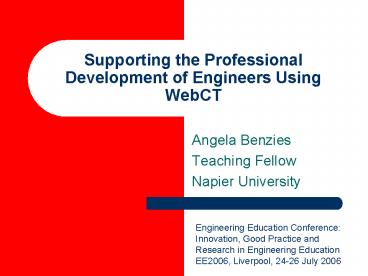Supporting the Professional Development of Engineers Using WebCT - PowerPoint PPT Presentation
1 / 25
Title:
Supporting the Professional Development of Engineers Using WebCT
Description:
Innovation, Good Practice and Research in Engineering Education ... Employer and employee attitudes ... comfortableness with the process of interacting online ... – PowerPoint PPT presentation
Number of Views:39
Avg rating:3.0/5.0
Title: Supporting the Professional Development of Engineers Using WebCT
1
Supporting the Professional Development of
Engineers Using WebCT
- Angela Benzies
- Teaching Fellow
- Napier University
Engineering Education Conference Innovation,
Good Practice and Research in Engineering
Education EE2006, Liverpool, 24-26 July 2006
2
Is career development a priority?
- Investment in development delivers benefits
- Professional Engagement (PE) is important
- networking
- sharing information
- Employer and employee attitudes need to be
addressed - Obstacles
- IET Engineering Management, April/May 2006
3
What type of education?
- Breadth of knowledge
- Application of theory to real problems
- Courses aligned with industry needs
- Relevant to individuals
- Accessible
- Engaging
Educating Engineers for the 21st Century the
Industry View Henley Management College, for the
Royal Academy of Engineering
4
BEng Product Manufacture
- A one-year top up programme
- For those with a relevant HND or equivalent
- To take students to ordinary degree level
- Target market people working full-time in
industry - Distance learning format
- Primarily utilising WebCT
- No face to face contact
5
SE32329FL Introduction to Project Management
Module Concept
- Relevance to part-time students
- Addresses industrial needs
- Aims to enhance project team member performance
- Will facilitate CPD generally
- Based on professional body requirements
- Uses relevant British Standards within teaching
and learning materials - Active learning
6
Module Structure
- 13 Units of study
- Unit 0 is module introduction
- Units 1 to 12 cover syllabus
- Units comprise introduction learning outcomes,
study instructions, activities and summary - 40/60 split of continuous and supervised
assessment - Typically 5 activities per unit, a mix of
postings and assignments, with simple marking
rubric for postings
7
(No Transcript)
8
(No Transcript)
9
Module Introduction
- Cover essentials, e.g. WebCT usage
- Set expectations and clarify procedures
- Set the tone
- Draw together and discuss information from other
sources - Get students online and talking
- Start promoting a sense of community
10
(No Transcript)
11
(No Transcript)
12
(No Transcript)
13
Online Discussion Grading Rubric
- 0 pts Student either does not participate or
repeats and/or affirms statements made. - 1-2 pts Student introduces and summarises
assigned readings related to the questions
posted. - 3-4 pts Student analyses questions, identifies
patterns and engages fellow learners - 5 points Student consistently challenges
existing theories, researches new ideas and
engages and is responsive to fellow learners.
Christina Mainka, Educational Development, Napier
University
14
Module Support Philosophy
- Systems, materials and processes designed to
minimise the need for remedial e-support. - Other key aspects of BS8426 include
- Quality and effectiveness generally
- Clarity and relevance specifically
- Opportunities for practice of activities
- Short paths to support
- Clear and timely information on deadlines
BS84262003 A code of practice for e-support in
e-learning systems
15
(No Transcript)
16
(No Transcript)
17
Student Evaluation Key points
- Theoretical knowledge gained will enhance their
work. - Now have better understanding of own company
operations. - General learning skills were developed.
- Companies were mainly very supportive.
- Students interested in gaining professional
qualifications. - Structured activities helped maintain a
consistent student effort throughout the module
and kept them on track. - The discussion tool was helpful.
- Students liked using technology to learn.
18
Conclusions
- VLE usage can effectively support professional
development through providing - flexible access to industrially relevant
programmes - professional engagement and networking
- enhancement of learning skills
- but it requires
- well structured online teaching
- effective learner and system support
- involvement of industry
19
E-tutoring just common sense?
- "In my view, too much is made of training tutors
and this makes online tutoring seem more
difficult and more unknown than it really is. The
components of learning to tutor online are - familiarity with the conferencing software and
how to get online - comfortableness with the process of interacting
online - knowledge of what the particular online course
requires of the student - The rest is commonsense and intelligent
transferring of the art and skill of teaching to
the online environment. Ultimately there is no
substitute for getting online and experiencing a
range of ways of interacting online." - Quote from an educational technology practitioner
on JISC Infonet VLE site http//www.jiscinfonet.a
c.uk/InfoKits/effective-use-of-VLEs
20
Current and future work
- Development of
- training for online teaching
- quality systems
- pedagogical models
- ways of sharing knowledge
- Research projects
- Transforming and Enhancing the Student Experience
through Pedagogy (TESEP) - Mod4L
21
(No Transcript)
22
(No Transcript)
23
(No Transcript)
24
Finally
- Need to incorporate
- new technology, e.g. WebCT Vista
- new (staff) skills
- research findings
- existing good practice guides
- and refine
- assessment, file handling, system interactions
- while remaining relevant and engaging
25
Additional References
- IET Management, April/May 2006 http//www.iee.org/
oncomms/sector/management/magazine.cfm?issueID108
- Educating Engineers for the 21st Century the
Industry View, The Royal Academy of Engineering
http//www.raeng.org.uk/education/ee21c/default.ht
m - Mainka, C and Benzies A. Learning to Teach
Online from the Students Perspective. Napier
University Conference Using the curriculum to
address the needs of individual students, June
2005 - Mod4L http//www.academy.gcal.ac.uk/mod4l/)
- WebCT at Napier University http//www.ed.napier.ac
.uk/learntec/WebCT.htm - Napier online induction http//www.napier.ac.uk/o
nlineinduction/































